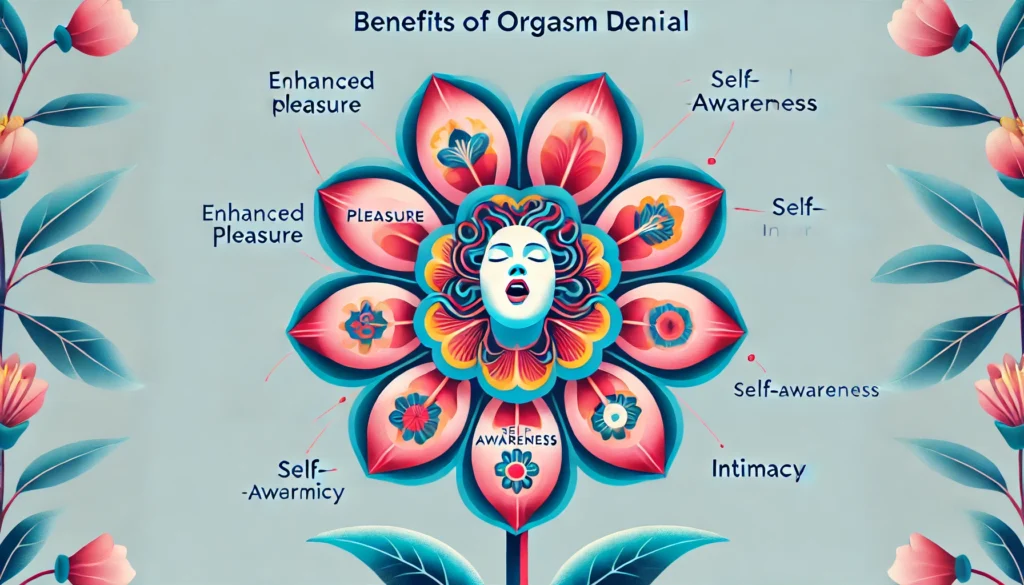Female orgasm denial has gained popularity in recent years, offering a unique way to explore pleasure and power dynamics in intimate relationships. It involves deliberately withholding or postponing climax to intensify sexual experiences. It’s not just about saying “no” – it’s a complex interplay of anticipation, control, and heightened arousal. You’ll discover how this practice can enhance intimacy, boost sexual satisfaction, and even improve overall well-being.
Table of Contents
Key Takeaways
- Female orgasm denial involves intentionally delaying or preventing climax to intensify sexual experiences and explore power dynamics.
- Types of orgasm denial include solo practice, partner-assisted denial, and restraint-based denial, each offering unique sensations and benefits.
- Benefits of orgasm denial include enhanced pleasure, improved self-awareness, deepened intimacy, and exploration of power dynamics.
- Practice orgasm denial safely by setting clear boundaries, starting slowly, and using safe words to ensure comfort and enjoyment.
- Prioritize aftercare practices such as cuddling, communication, and hydration to maintain emotional well-being and physical health post-session.
What Is Female Orgasm Denial?
Female orgasm denial is a sexual practice where you or your partner intentionally delay or prevent orgasm during intimate encounters. This technique involves building sexual tension and arousal without allowing release, often for extended periods. By reframing traditional concepts of climax, orgasm denial transforms the entire sexual experience.
Key FUN aspects of female orgasm denial include:
- Consensual power dynamics (this is not a one way street)
- Prolonged arousal states (requires mental fortitude)
- Edging (bringing yourself or partner close to orgasm without climaxing)
- Tease and denial techniques (foreplay!)
- Mental and physical stimulation without release (takes practice!!)
Orgasm denial can be done in various ways:
- Solo play: You control your own stimulation and orgasm
- Partner-controlled: Your partner decides when or if you’ll climax
- Time-based: Setting specific periods for abstaining from orgasm
- Task-oriented: Orgasm is allowed only after completing certain actions
Healthy practice often involves:
- Communication: Establishing clear boundaries and consent
- Trust: Surrendering control to a partner
- Patience: Embracing delayed gratification
- Exploration: Discovering new sensations and pleasure points
By incorporating orgasm denial, you’re shifting focus from the end goal of climax to the journey of arousal and sensation. This can lead to increased sexual awareness, heightened sensitivity, and potentially more intense orgasms when finally achieved. You can learn more on how to have an orgasm
Types of Orgasm Denial
Female orgasm denial encompasses various techniques and methods, each offering unique experiences and sensations. Here’s an exploration of the different types you can incorporate into your intimate encounters:
Solo Practice
Solo orgasm denial involves self-control and exploration of your own body’s responses. You’ll stimulate yourself to the brink of climax, then pause or stop completely. This practice helps you:
- Develop a deeper understanding of your arousal patterns
- Enhance self-control and discipline
- Intensify sensations when you finally allow release
- Experiment with different stimulation methods and sex toys
Try edging techniques using your hands or vibrators, gradually increasing intensity and duration as you become more comfortable with the practice.
Partner-Assisted Denial
Partner-assisted denial introduces power dynamics and shared experiences into your intimate moments. Your partner takes control of your pleasure, deciding when and if you’re allowed to orgasm. This type includes:
- Verbal commands and instructions
- Physical stimulation and withdrawal
- Use of sex toys controlled by your partner
- Timed sessions where orgasm is prohibited
Communication is important in partner-assisted denial. Establish clear boundaries, safe words, and agreed-upon signals to ensure a safe and enjoyable experience for both partners.
Restraint-Based Denial
This form of denial incorporates physical restraints to prevent or limit access to areas of stimulation. Restraint-based denial can involve:
- Chastity devices like belts or cages
- Bondage equipment such as ropes or cuffs
- Sensory deprivation tools like blindfolds or earplugs
When engaging in restraint-based denial, prioritize safety. Use proper equipment, maintain open communication, and have a plan for quick release if needed. Start with shorter sessions and gradually increase duration as you become more comfortable with the practice.
Benefits and Motivations
Female orgasm denial offers several benefits and motivations for those who practice it:
Enhanced Pleasure and Anticipation
Orgasm denial intensifies sexual experiences by:
- Prolonging arousal periods
- Increasing sensitivity to touch
- Amplifying the eventual orgasm’s intensity

This heightened anticipation often leads to more powerful and satisfying climaxes when release is finally permitted.
Improved Self-Awareness and Control
Practicing orgasm denial helps you:
- Gain better understanding of your body’s responses
- Develop greater control over arousal levels
- Explore new sensations and erogenous zones
This increased self-awareness can translate to more fulfilling sexual experiences overall.
Deepened Intimacy and Communication
Engaging in orgasm denial with a partner:
- Fosters open discussions about desires and boundaries
- Builds trust through shared vulnerability
- Encourages non-verbal communication during intimate moments
These factors contribute to stronger emotional connections and improved relationship satisfaction.
Power Dynamics Exploration
For some, the appeal of orgasm denial lies in:
- Consensual submission to a partner’s control
- Experiencing the thrill of surrendering sexual agency
- Exploring dominance and submission roles safely
This practice allows couples to experiment with power dynamics in a controlled, intimate setting.
Mental and Physical Stimulation
Orgasm denial combines:
- Psychological arousal through anticipation and teasing
- Physical stimulation without immediate release
- Mental challenges of maintaining arousal without climaxing
This blend of mental and physical elements creates a unique and intense sexual experience.
How to Practice Orgasm Denial
Practicing orgasm denial requires clear communication, consent, and a gradual approach. Here’s how to incorporate this technique into your sexual experiences safely and effectively.
Setting Boundaries and Consent
Establish clear boundaries and obtain enthusiastic consent before engaging in orgasm denial. Discuss your desires, limits, and expectations with your partner. Define sexual boundaries and set limits on the scene to ensure a comfortable and enjoyable experience for both parties. Regular communication about your wants and needs is important to maintain trust and safety throughout the practice.
Starting Slowly
Begin your orgasm denial journey gradually to build comfort and understanding. Educate yourself on the basics through workshops or online classes to establish a solid foundation. Start with solo practice to familiarize yourself with the sensations and determine your personal boundaries. This self-exploration allows you to understand your body’s responses and limits before involving a partner.
Using Safe Words
To maintain emotional safety you may want to have a safe word system to ensure clear communication during orgasm denial play. Choose a word or phrase that’s easy to remember and distinct from typical bedroom talk. Establish a “yellow” word to signal a need to slow down or adjust, and a “red” word to stop the activity immediately. Respect these safe words without question when used, maintaining trust and safety throughout the experience.
Orgasm Denial vs. Edging
Orgasm denial and edging are distinct sexual techniques that enhance pleasure and build anticipation. While often confused, they serve different purposes in your intimate experiences.
Orgasm Denial
Orgasm denial involves deliberately postponing or withholding climax. You or your partner control when, or if, you’ll reach orgasm. This technique:
Edging brings you to the brink of orgasm repeatedly before allowing release. This method.
Key Differences
Aspect | Orgasm Denial | Edging |
|---|---|---|
Goal | Withhold orgasm | Delay orgasm |
Duration | Hours to days | Minutes to hours |
Outcome | May not result in orgasm | Always ends in orgasm |
Focus | Control and submission | Pleasure intensification |
Incorporating either method into your sexual repertoire can deepen intimacy and heighten pleasure. Choose the technique that aligns with your desires and boundaries for a more fulfilling sexual experience.
Safety Considerations
Safety is paramount when practicing female orgasm denial. Consider these important physical and emotional aspects to ensure a positive experience.
Physical Health Precautions
Prioritize your physical well-being during orgasm denial practices. Medical conditions like diabetes, multiple sclerosis, and hormonal imbalances can affect your ability to orgasm. Certain medications, particularly SSRIs used for depression treatment, may decrease libido and orgasmic function. If you’re undergoing hormonal therapy, especially during menopause, be aware that vaginal dryness and pain can make orgasm more challenging. Educate yourself or work with your healthcare expert about potential treatments, such as estrogen or androgen therapy, to address these issues. Remember, the effectiveness and risks of these treatments vary, so discuss your options thoroughly with a medical professional.
Emotional Wellbeing
Your emotional state plays a important role in orgasm denial practices. Establish clear communication with your partner about boundaries, expectations, and consent. Create a safe space where you feel comfortable expressing your desires and concerns. Regularly check in with yourself and your partner to ensure the experience remains positive and enjoyable. If you notice feelings of anxiety, frustration, or discomfort, take a step back and reassess. Remember, orgasm denial should enhance your sexual experience, not cause distress. Practice self-care and be mindful of your emotional limits throughout the process.
Implementing these practices helps ensure a positive experience and strengthens the trust between partners. Tailor aftercare to individual needs and preferences for optimal results.
Aftercare Practice | Benefits |
|---|---|
Cuddling | Promotes bonding, releases oxytocin |
Massage | Releases muscle tension, improves circulation |
Hydration | Replenishes fluids, prevents dehydration |
Communication | Addresses concerns, strengthens emotional connection |
Comfort measures | Reduces stress, promotes relaxation |
Nutritional support | Restores energy levels |
Emotional reassurance | Reinforces trust, enhances intimacy |
Aftercare isn’t limited to partnered activities. Solo practitioners of orgasm denial benefit from self-care practices like warm baths, journaling, or engaging in relaxing activities post-session.
Remember, aftercare needs vary. What works for one person may not work for another. Experiment with different techniques to find the most effective aftercare routine for you or your partner.
Conclusion
Female orgasm denial can be an exciting way to enhance your sexual experiences. By understanding the differences between denial and edging, prioritizing safety, and implementing proper aftercare, you’ll create a more fulfilling and enjoyable practice. Remember communication and trust are key to exploring this intimate activity. Whether you’re engaging in solo play or with a partner, take time to discover what works best for you. With patience and experimentation, you’ll unlock new levels of pleasure and intimacy through female orgasm denial.











